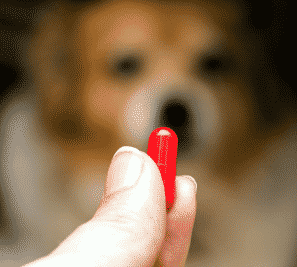It’s a heartbreaking story.
Individuals with substance use disorders so desperate for drugs that they are harming animals for opioids or other substances: injuring or cutting them, taking them to veterinarians, then using the medications themselves.
Is pet owners using animals to get opioids a real problem, a potential problem, or an urban legend?
Are People Using Pet Meds?
 Law enforcement officials specializing in pharmaceutical diversion say such abuse has happened. What’s not clear is how often.
Law enforcement officials specializing in pharmaceutical diversion say such abuse has happened. What’s not clear is how often.
Some researchers admit they have concerns but no evidence. Others speculate how prevalent such abuse is and why we don’t know (lax drug control procedures, little or no drug testing of employees). Still, there are anecdotes.
For example, in 2014, a Kentucky woman admitted to cutting her golden retriever on at least four occasions to obtain tramadol, an opioid analgesic (pain reliever).
Tramadol is a controlled substance that is considered a less risky pain reliever than oxycodone, as reflected by its placement on Schedule 4 on the Drug Enforcement Administration’s list of controlled substances. (Oxycodone is on Schedule 2. Heroin, which is illegal and cannot be prescribed, is on Schedule 1.)
Commonly Abused Veterinary Drugs
Discussing his work to combat drug diversion, former law enforcement officer John Burke noted that commonly abused veterinary drugs include:
- Diazepam for anxiety
- Hydrocodone for coughs
- Narcotics for pain
- Anabolic steroids for building muscle
- Phentermine for weight loss
Not that harming a pet is the only way to use pets to obtain drugs, Burke said. People with substance use disorders engaged in the same kinds of behavior with veterinary offices as with physicians’ offices, including:
- Visiting multiple doctors to accumulate a large amount of drugs. One man taught his dog to cough on command so the man could obtain prescription hydrocodone cough syrup.
- Seeking employment at veterinarians’ offices to steal drugs. A man volunteered at a local vet’s office so he could pilfer anabolic steroids and sell them to a local gym.
- Burgling doctors’ offices or pharmacies. As in the film Drugstore Cowboy, some people with addictions go right to the source.
- Neighbors, friends, or family taking forgotten, unused, or leftover pet prescriptions found around the home.
- Veterinarians writing prescriptions for nonexistent patients. Vets are at greater risk of mental health issues that may contribute to substance use disorder (SUD)—a dual diagnosis or co-occurring disorder—than the general public. A dual diagnosis occurs when someone has a substance use disorder and a mental illness at the same time. One veterinarian confessed to inventing an overweight Labrador retriever to justify taking home thousands of diet pills.
Burke wrote about drug diversion in 2002, before the opioid crisis exploded into the public’s consciousness. Since then, it has become much harder for individuals with substance use disorders to divert prescription drugs for people. This has led to an increase in black market drug use. People with SUDs are using and overdosing on stronger illegal or illicit drugs such as heroin and illegally produced fentanyl.
Unless there has been a similar increase in vigilance towards pet medicines and veterinarians, it’s logical to anticipate that addicts might move down the food chain.
Evidence for Pet Med Diversion
Aside from a few anecdotal reports, there is little evidence of this, but that may just be because no one has looked. In 2018, in an article published in the American Journal of Public Health, researchers “found no published studies in the peer-reviewed literature on veterinary opioid-prescribing rates or on the risk of diversion.”
On the other hand, a small survey of Colorado veterinarians found that:
- 44% said they knew of clients or staff who misused opioids.
- 13% said they knew of a pet owner who had made an animal sick or injured—or to seem so—in an attempt to obtain opioids.
- 12% said they knew of staff who abused or diverted opioids.
Whether or how much of a problem this is, at least 15 U.S. states now require veterinarians to check the pet owners’ prescription history to help ensure that they are not using their pets’ drugs themselves. Many vets object to this, saying they are not qualified to do so and that client privacy prohibits these searches. About two-thirds of U.S. states prohibit such checking.
Dangers of People Using Pet Meds
Client checks and other more stringent requirements aren’t needed, say some critics, because cats and most dogs are smaller than people and require smaller doses of medications. Size isn’t everything, however.
Pets have faster metabolisms, so they may actually require larger doses of medications. If humans taking a pet medication think that, however, they might use a larger dose than they intended, maybe a fatal dose.
Even without the difference in the strength of dosage, people aren’t large cats or dogs. Different substances have different effects on people and pets. That chocolate can be poisonous to dogs is well-known. Humans taking their pets’ drugs might face similar risks.
Misusing pet opioids such as tramadol is not without danger for pets or people. Both have experienced seizures after taking tramadol. Just because a medication was safely prescribed for one pet doesn’t guarantee that it will be safe for another pet or a human.
How to Prevent Pet Meds Diversion
In 2018, the Food and Drug Administration (FDA) published the guide The Opioid Epidemic: What Veterinarians Need to Know.
 The FDA recommends watching out for:
The FDA recommends watching out for:
- Pet owners who ask for a drug by name. It could be that the pet has a recurring problem and this drug has worked in the past, but it could be that the pet owner is feeding an addiction. Be suspicious.
- Pet owners who report losing the medication and request a refill. Accidents happen, people are careless, but watch for other warning signs.
- Pet owners who are a little too insistent that their pets need medications. People can be emotional about the health and comfort of their pets, but there’s a difference between that concern and a drug user who needs a fix.
There are also proactive steps veterinarians can take to prevent pet medication abuse, including:
- Find alternatives to opioids for pain management. Opioids for pets are few and hard to come by, especially since the FDA has withdrawn its approval for super-potent drugs such as fentanyl and carfentanil. There are still a few opioids so approved (buprenorphine, butorphanol), but the risks of addiction and diversion make non-opioid remedies more desirable. Research is underway.
- Monitor pet prescriptions as exactingly as people’s. At least 15 U.S. states now have some form of prescription drug monitoring program (PDMP) for pets as well as people, but more than 30 don’t. That must change. Just as physicians must check that their clients aren’t doctor shopping, so, too, must vets.
Substance use disorder in general and opioid use, in particular, remain a problem. Even absent direct evidence of widespread abuse, veterinarians need to be aware of and take action to stop the possible use of veterinary medications by people.
References
- reuters.com – Opioid prescriptions for pets surge, mirroring human crisis
- veterinarynews.dvm360.com – Dark shadows: Drug abuse and addiction in the veterinary workplace
- wkyt.coml – Hardin Co. woman accused of cutting dog to use dog’s pain medication
- pharmacytimes.com – Drug Diversion in Veterinary Medicine
- pennmedicine.org – Does Opioid Use in Pets Create Higher Risk for Abuse in Humans
- cdc.gov – Notes from the Field: Prevalence of Risk Factors for Suicide Among Veterinarians — United States, 2014
- dartmouth.edu – Dual Diagnosis: Mental Illness And Substance Use Disorder
- ajph.aphapublications.org – Prescription Opioid Epidemic: Do Veterinarians Have a Dog in the Fight?
- pewtrusts.org – War on Opioids Moves to Veterinarians’ Offices
- fda.gov – The Opioid Epidemic: What Veterinarians Need to Know
- americanveterinarian.com – Pets, Vets, and Opioids
- fda.gov – Statement by FDA Commissioner Scott Gottlieb, M.D., on the FDA’s new resource guide to support responsible opioid prescribing for pain management in animals
- now.tufts.edu – Investigating Alternatives to Opioids for Dogs in Pain
- cdc.gov – What States Need to Know About PDMPs
Medical disclaimer:
Sunshine Behavioral Health strives to help people who are facing substance abuse, addiction, mental health disorders, or a combination of these conditions. It does this by providing compassionate care and evidence-based content that addresses health, treatment, and recovery.
Licensed medical professionals review material we publish on our site. The material is not a substitute for qualified medical diagnoses, treatment, or advice. It should not be used to replace the suggestions of your personal physician or other health care professionals.







